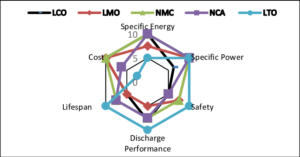In a world accelerating ever faster toward all-electric, it’s easy to forget that the lithium-ion catalyst behind this momentum is a mere three decades young. Though the lithium-ion revolution burns brightly, integration in battery systems is often difficult due to lack of standardization.
Oliver Bald, Senior Manager for Business Development, and Santiago Antolin, Senior Field Applications Engineer at Inventus Power, lend their expertise on the matter.
Join our recap of this dynamic discussion: Accelerating Electrification of Off-Highway Equipment through Standardization.
The Lithium Paradigm: Driving Demand
Today’s marketplace is marked by two pivotal technological transitions:
- A shift from the traditional combustion engine to electric drivetrains.
- Progression from legacy technologies—primarily lead acid-based—towards lithium-based energy storage systems.
These transitions, kick-started by legislative demands for zero CO2 emissions, nonetheless offer several advantages.
- From combustion to lithium – In addition to meeting sustainability directives, lithium offers enhanced safety, lower maintenance costs, and reduced noise operations for instances like overnight usage.
- Lead acid to lithium – Historically, lead acid was bound by its operational profile—one charge for one discharge cycle daily. Not so with lithium, offering opportunistic charging, extended lifecycle, and maintenance-free operation.
As these technologies advance, power consumption soars in tandem. This is the demand that has driven Inventus Power to transition further toward off-highway and industrial sector battery solutions.
Mapping the Need for Standardization
Navigating the challenges of battery integration presents distinct methodologies. Traditionally, the modus operandi gravitated toward custom designs. While this ensures precision, it also brings along inherent challenges of time and cost.
Yet for numerous applications and clients, projected volumes don’t necessarily justify the investment in a custom design. As battery packs scale up, so do their complexity and associated costs.
Enter standardized solutions. By tailoring a portfolio that caters to diverse segments, the benefits multiply:
- Faster time to market – From an average of 18+ months to less than 6 months.
- Cost-effectiveness – With pre-certified packs, integration is not only expedited but also more economical.
- Future-proof – Standardized packs offer clients the versatility to base future platforms on these consistent standards.
While each method has its merits, today’s focus leans toward standardization, particularly for off-highway applications. From this position, we can distill the essence of standardization into four guiding tenets:
- Standard, modular sizes to match intended applications
- Compatibility across internal components
- Streamlined installation hardware and user experience
- Data analytics, such as local duty cycle analysis or remote IoT data tracing
These principles serve as pathways toward a resilient and responsive future energy infrastructure. As we next examine the elements of optimal battery design, note how they reflect these pillars of standardization.
Optimal Battery Sizing
In addition to modularity and scalability, standardized sizing on battery packs offers a significant benefit in regards to flexibility of installation:
- Simplified installation process across a variety of vehicle dimensions, profiles, and enclosures
- Lightweight and ergonomic design, facilitating single-person installation and servicing
- Modular installation allows for units to serve as counterweights or to ensure center of gravity
Such a design enables delivery of optimal power and performance based on the intended machine duty cycle.
Compatibility in Battery Cells and Management System
At the heart of any battery lies its cell, selected based on power requirements, environmental contexts, and distinct load profiles. The three standard cell types are:
- Lithium titanium oxide (LTO)
- Lithium iron phosphate (LFP)
- Lithium nickel cobalt manganese aluminum (NCMA)
Each cell variant provides a unique balance in performance metrics such as charge rate, energy density, longevity, and cost-effectiveness.
Working in tandem with these cells is the Battery Management System (BMS), acting as the battery pack ‘brain’. It monitors the cell’s charge and discharge while also supervising essential parameters like voltages and temperatures.
By aligning with the specific cell’s attributes, the BMS ensures the battery’s protection and seamlessly communicates external diagnostics and safety checks.

Levels of Battery System Integration
Battery system integration has evolved to accommodate varying levels of communication between critical components such as the vehicle control unit, charger, and battery. This intricate coordination can be classified into three primary tiers:
- Basic integration – This level emulates a traditional lead-acid battery setup, offering no interaction between the vehicle control unit, charger, and battery. Each component operates with minimal intelligence and in relative isolation.
- Semi-integration – Establishes a closed-loop communication between the battery’s BMS and the charger. This facilitates what’s termed a ‘smart charge’ process, wherein data is actively exchanged to optimize the battery’s charging cycle in real-time.
- Full Integration – All devices here are constantly sharing instantaneous data. In this intelligent environment, diverse charging options, whether wired or wireless, onboard or offboard, can be accommodated. This introduces new possibilities, such as DC fast charging and machine learning to fine-tune performance.
The progression in these integration levels, from simplicity to sophisticated synchronicity, epitomizes both the challenges and advancements in modern battery systems. It also emphasizes the pressing need for standardization.
Compliance, Safety, and Transportation
Though compliance regulations may differ, the universal commitment to safety is a non-negotiable cornerstone, especially in the quest for standardization.
Essential safety and performance tests include:
- UN 38.3 for transit – A broad array of tests, from measuring vibration and ingress protection to in-depth crash assessments, nail penetration tests, and immersion checks.
- ECE R100 for on road vehicles – Tests a battery’s resilience against external fires for roughly two minutes. Also evaluates potential risks such as shock and external short circuits.
- Performance testing – Including Accelerated Life Testing (ALT), PPAP verification, and high-temperature calendar life assessment.
Beyond compliance, best practices regarding the transportation and storage of batteries must be adhered to. These include:
- Storing between 30% to 50% state of charge (SOC)
- Verifying SOC once every 12 months
- Charging when below 10% SOC, or every two years
- Complying with SOC requirements in accordance with the method of transport
Adherence to these compliance and safety benchmarks not only ensures peak battery performance but also lays the foundation for their safe integration across varied applications.
Standardization in Summary: The Electric Highway Ahead
As the gears of the industry turn ever faster, the destination is unmistakably electric. Beyond the labyrinth of battery intricacies and the bedrock of safety regulations, standardization offers a streamlined roadmap—especially for high voltage demands of off-highway machinery and the wider commercial sector.
On this electrifying journey, Inventus Power, a Charged by Delta-Q partner, is not just a traveler but a trailblazer—a stalwart beacon chartering the path toward an all-electric future.




